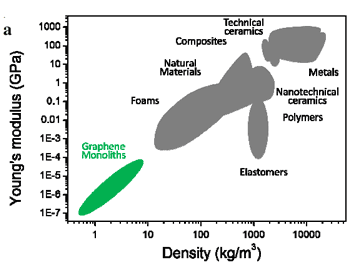December 11, 2012
Few materials in recent memory have gotten as much attention as graphene, a material composed of a sheets of carbon that is one atom thick. On the pages of MPMN, we have written stories on the materials impressive materials with titles such as Going Gaga Over Graphene and Graphene Arrays Could Revolutionize Electronics.
|
The graphene monoliths have a density that is much less than that of conventional materials. |
For a crystal, the material is relatively elastic, capable of stretching up to 20% of its length. The materials' usefulness, however, is limited when graphene is stacked, as it becomes brittle. For that reason, much of the research that has been done on the material has focused on applications of individual sheets of the material.
Researchers at Monash University in Victoria, Australia have developed a superelastic 3-D graphene-based material with a structure resembling that of cork. The ultralight graphene monoliths could withstand loads of more than 50,000 time its weight and can recover from deformation exceeding 80%. The novel material could be used in conductive biological implants, tissue scaffolds, and flexible electronics.
The scientists were able to create the material by using a technique known as freeze casting, which molded chemically modified graphene into a multidimensional structure that is extremely light.
Brian Buntz is the editor-at-large at UBM Canon's medical group. Follow him on Twitter at @brian_buntz.
About the Author(s)
You May Also Like



